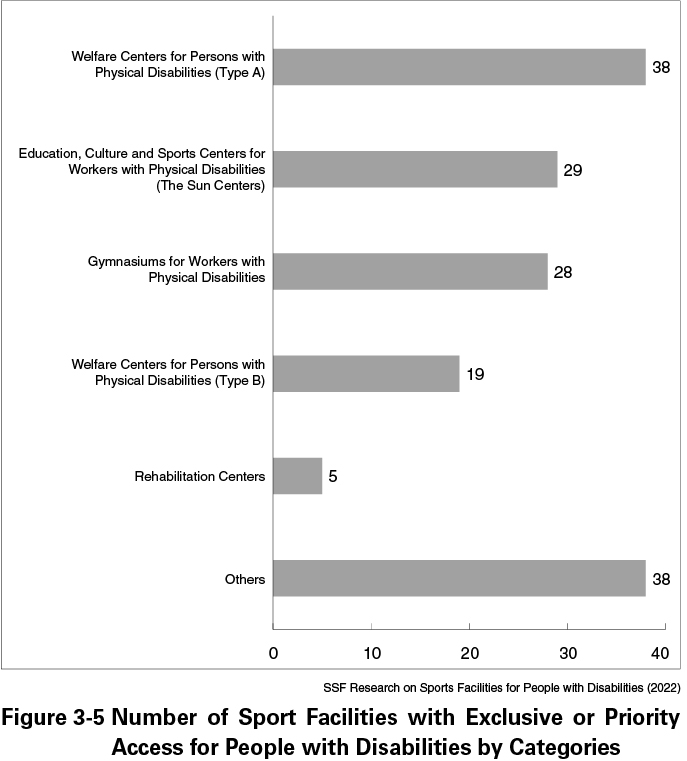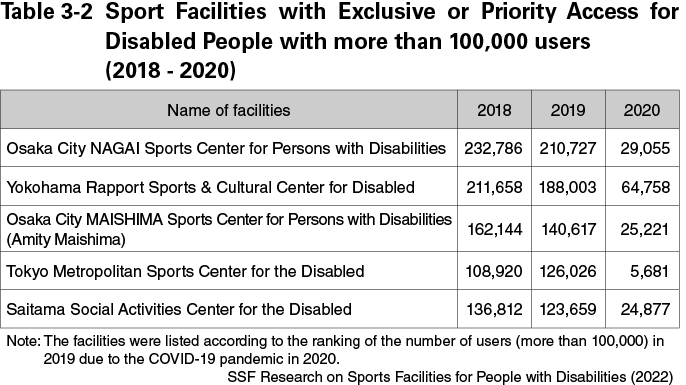1. Sport Centers for People with Disabilities
Sport centers for people with disabilities allow people with disabilities to have exclusive or priority access. These centers are equipped with a range of facilities, such as gymnasiums, swimming pools, playgrounds and training rooms, which have been designed to be more easily used by people with disabilities. The SSF “Research on Sports Facilities for People with Disabilities” (2022) reported that there were 150 such facilities in Japan in 2021. Of these, 85.5% of facilities are equipped with gymnasiums, 45.5% with training rooms, 41.8% with swimming pools, 27.3% with multi-purpose rooms, 26.4% with sound table-tennis rooms and 18.2% with archery ranges.
Along with universal design features, such as the elimination of steps, the installation of braille blocks and barrier-free restrooms, to accommodate the needs of people with disabilities, these facilities also offer a variety of information resources to assist people with disabilities. Such resources include the use of visual displays for people with intellectual disabilities and an electronic bulletin board to assist people with hearing impairments. Moreover, tools and equipment that allow people with disabilities to participate in sport, as well as full-time disability sport instructors are available in most of the centers, which often serve as a community hub for disability sport activities.
Based on the background purposes for their establishment, sport centers for people with disabilities can be divided into the following seven types (Figure 3-5). By March 2006, all type 2 and type 3 facilities were transferred to municipalities and they are currently being managed by the Council of Social Welfare and social welfare corporations and organizations.
- Welfare Centers for Persons with Physical Disabilities (Type A)
Facilities specified in the Act for the Welfare of Physically Disabled Persons, aimed at supporting social participation of persons with physical disabilities.
- Gymnasiums for Workers with Physical Disabilities
Facilities formerly known as “Gymnasiums for Workers with Physical Disabilities” were established in 1961 by the Employment Promotion Corporation, with the aim of improving welfare and more stable employment of workers with physical disabilities.
- Education, Culture and Sports Centers for Workers with Physical Disabilities (The Sun Centers)
Facilities formerly known as “Education, Culture and Sports Centers for Workers with Physical Disabilities (The Sun Centers)” were also established by the Employment Promotion Corporation, with the aim of making use of available facilities to improve the physical functions, physical fitness, communication, education and cultural welfare of workers with physical disabilities.
- Welfare Centers for Persons with Physical Disabilities (Type B) Welfare centers as defined by the Act on Welfare of Physically Disabled Persons that are at least 424 square meters in size and offer creative activities, opportunities to be productive, encouragement to interact with the world, volunteer training and other services that will help people with physical disabilities participate in society.
- Rehabilitation Centers
Facilities that offer complete support services to people with disabilities, from functional recovery training to reentry into society.
- Recovery Centers for Persons with Disabilities
These welfare centers are designed for people with physical disabilities in order to improve their health and social participation by providing a place where they or family members can freely lodge, rest or engage in recreation at.
- Others
Facilities that have been established by prefectures or ordinance- designated cities for purposes other than those listed above (1 to 6).
2. Usage of Sport Facilities with Exclusive or Priority Access for People with Disabilities
The method each sport facility with exclusive or priority access for disabled people uses to calculate visitor numbers varies; 47.2% of these facilities determine it by totaling the number of individuals who complete the sign-up process at the reception desk, while 44.4% count for the number of users of each section of the facility. All of the facilities that had over 100,000 total visitors (including people with disabilities) in 2019 are located in major cities and are ranked as follows, from most visitors to least (Table 3-2): Osaka City NAGAI Sports Center for Persons with Disabilities; Yokohama Rapport Sports & Cultural Center for Disabled; Osaka City MAISHIMA Sports Center for Persons with Disabilities (Amity Maishima); Tokyo Metropolitan Sports Center for the Disabled; and Saitama Social Activities Center for the Disabled. All the top ten facilities with the highest number of users with disabilities in 2019 experienced a significant decrease in the number of them in 2020.
3. Sport Facilities with Exclusive or Priority Access for People with Disabilities during the COVID-19 Pandemic
While the restrictions imposed by the COVID-19 pandemic, such as the declaration of the state of emergency and priority measures to prevent the spread of the COVID-19 infections, varied by region and time, the temporary closures of facilities and restrictions on their use affected the number of users. Since 2012, the total number of facility users had hovered around 7 to 8 million persons and the number of users with disabilities around 2.5 million. However, both dropped by half in 2020 due to the COVID-19 pandemic. The rate of decline in usage from 2019 to 2020 was down 54.1% in the total number of users, down 59.2% in the number of users with disabilities and down 80.3% in the number of users with multiple disabilities. Tokyo Metropolitan Sports Center for Persons with Disabilities and Tokyo Tama Sports Center for Persons with Disabilities both saw declines of more than 90%. Four of the top five facilities in terms of the rate of decline were in Tokyo and Osaka, and the decline rate was higher for larger cities with a larger number of COVID-19 cases, due to more closures of facilities and restrictions on their use. Furthermore, it can be inferred that people with disabilities with a higher risk of facing severe illness were more likely to avoid using facilities, resulting in that people with multiple disabilities refrained from using the facilities.


